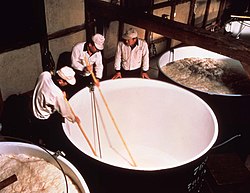Sake
Sake (Japanese:酒; pronounced 'sa.kɛ' ![]() Listen (info • help)) is a Japanese word for "alcoholic drink". In English, "sake" means one kind of alcoholic drink made from rice. In Japan, people call this drink nihonshu (日本酒 "Japanese alcohol") or sake. This article uses the word "sake" as it is used in English.
Listen (info • help)) is a Japanese word for "alcoholic drink". In English, "sake" means one kind of alcoholic drink made from rice. In Japan, people call this drink nihonshu (日本酒 "Japanese alcohol") or sake. This article uses the word "sake" as it is used in English.
Ingredients
Sake is a fermented drink. Most sake is made from rice, water, kōji, and yeast. Sometimes a small amount of lactic acid is used in brewing. Water or small amounts of pure alcohol can be added at the end of production. Sake can have from 12 to 22% alcohol, but is usually around 15 or 16%. Lower quality mass-produced sake can have added sugar or flavorings.
Serving sake
Sake is usually sold in bottles that are either 720ml or 1.8L. Drinkers or servers in a restaurant may pour it into small cups called chokko directly from the bottle. Sake is also served in smaller bottles called tokkuri. A typical serving in a bar or restaurant is 180ml. People may share that amount. When drinking together in Japan, it is considered polite to pour drinks for other people rather than for yourself.
Amazake
Amazake is sweet, low or non-alcoholic sake.[1] Archived 2013-03-25 at the Wayback Machine
Sake Media
Sake barrel offerings at the Shinto shrine Tsurugaoka Hachimangū in Kamakura
A pair of sake flasks painted in gold and black lacquer. Momoyama period, 16th century.
Sake made with Kyokai yeast "Akairo kōbo" for pink nigorizake
Template:Tlit (the main fermenting mash) undergoing fermentation
The blue sake bottle displays "Yamada Nishiki" (山田錦) and "Junmai Daiginjo" (純米大吟醸) on the bottom label and "Bingakoi muroka nama genshu" (瓶囲無濾過生原酒) and "requiring refrigeration" (要冷蔵) on the top label. The label on the pink sake bottle indicates Usunigori muroka nama genshu.
Nigori, or unfiltered sake









